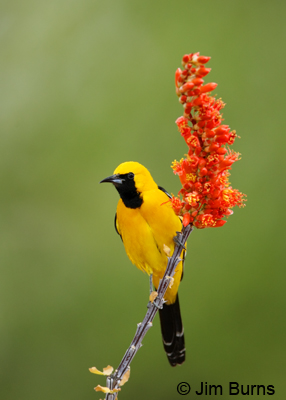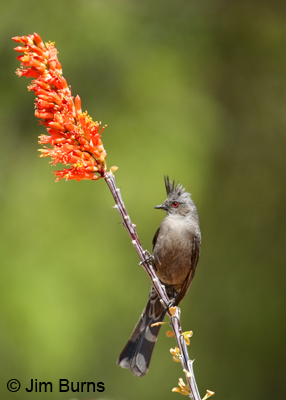|
Phainopepla |
Like streams of molten sunglow, glints of gold cascade through the deep green foliage of the Mexican Blue Oak as two male Hooded Orioles negotiate some avian territorial boundary visible only to themselves. As one slips away off the backside of the tree, the other, presumably the victor, swoops up to a landing at the apex of a blooming Ocotillo, his black chin and cape a stunning contrast to the plant's coral flowers.
In direct sunrise light the oriole's hood, breast, and belly, swaying with the movement of the Ocotillo's spindly stalk, pulse like yellow velvet as the bird channels his inner hummingbird and proceeds to examine each small bud for bugs and nectar. The real deal, a Broad-billed Hummingbird, its azure and emerald throat jewels ashine, hovers at a nearby stalk.
Somewhere upcanyon a Northern Cardinal is touting its own eponymous color--"PRE tty. PRE tty, PRE tty"--but the next bird into the scene is a male "desert cardinal," the more subtly beautiful wine-on-gray Pyrrhuloxia, which finds its own Ocotillo blossom to explore. The holy trifecta is complete when a pair of Phainopeplas, the "black cardinals," flip through the sunshafts on their morning flycatching foray. The anthracite male lands atop a Velvet Mesquite, but his mate lands on yet another Ocotillo stalk, below the flowers, her glistening eye a ruby exclamation point against her sooty body.
The cardinal, the real cardinal, has stopped singing, but sparrows have taken up the chorus. The "bouncing ball" cadence of the resident Rufous-winged emanates from the branches of the mesquite, competing with the soft bell-like tones of a Black-throated. A late-for-the-season White-crowned utters a few "old Sam Peabody" phrases, then comes in to bathe next to two Chipping Sparrows in a shallow rivulet, tributary to the main creek. A Lark Sparrow is picking seeds off the ground near a migrating Green-tailed Towhee, both looking contrasty and crisp in fresh spring breeding plumage.
A mother Gambel's Quail appears, shepherding half a dozen precocial miniatures sporting huge feet and bristly little mohawks at the front of their crowns where adult head plumes will soon appear. The adult male brings up the rear. They drink hurriedly and exit quickly to the sound of a Greater Roadrunner clacking its bill somewhere close by.
A male Lesser Goldfinch replaces the Hooded Oriole on the Ocotillo, but it's just a smaller version of the same color graphics--black on yellow against the coral background. Renewed oriole chatter announces the arrival of a pair of Bullock's, the male's black hood and eyeline separating it from the leaner, cleaner Hooded male which preceded it at the Ocotillo supermarket.
For the non-birder, passing quickly through on the highway, the desert appears a silent, monochromatic wasteland where time stands still. For the springtime birder, quietly watching at a waterhole, the desert is a kaleidoscope of sound and color where time passes all too quickly.

